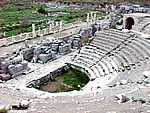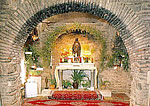About Ephesus, Ephesus History, Where is Ephesus
About Ephesus
In 334 B.C. Ephesus was conquered by Alexander the Great who initiated the reconstruction of the temple which had been set on fire by Hierostatus on the very night that the Macedonian champion was born. Ephesus became a great capital of Asia Minor after 133 B.C. when it became subject to Rome, and it also evolved as a centre for co mmerce. Amongst all the Roman-dominated cities in
Anatolia, Ephesus certainly has the best preserved and appreciated monuments but above all it is the city where the quality of Roman life can still be breathed today, and where one can form an impression of what life was like at that time.
mmerce. Amongst all the Roman-dominated cities in
Anatolia, Ephesus certainly has the best preserved and appreciated monuments but above all it is the city where the quality of Roman life can still be breathed today, and where one can form an impression of what life was like at that time.
Goths from Crimea conquered the city and looted the Temple of Artemis, then considered to be one of the wonders of the ancient world, and the citys decline dates from then. It was from here that first Paul the Apostle and then John began to spread Christianity. St Paul, who came from Tarsus, spent three years at Ephesus and founded the first of the seven churches mentioned in the Book of Revelations, before being ousted by Ephesians silversmiths. St. John lived here with the Virgin Mary while he wrote his gospel. In 100 A.D. St. John was buried in the city and Justinian erected a basilica over his tomb.
In 431 A.D. Theodosius II convened the Third Council at Ephesus, during which the Nestorian heresy was condemned and the Virgin Marys divine maternity affirmed.
 The Library of Celsus, reconstructed by Austrian archaeologists, is without doubt one of
Ephesus more important monuments. It was erected by
Tiberius Julius Aquila in memory of his father,
Julius Celsus Polimeanus (proconsul in Asia) in 135 A.D. His
Sarcophagus, of fine carved marble, is situated in the funerary chamber underneath the library. The two-storied building has a sumptuously decorated facade with
Corinthian columns and capitals together with niches filled with statues representing Wisdom and Intelligence. Three doors lead into the great reading
Bedroom, which in antiquity had a wooden roof, and where, in the centre, there stood a statue of
Athena. The marble-lined aligned walls contained niches where the parchment scrolls were kept. At that time the librarys collection amounted to around twelve thousand scrolls.
The Library of Celsus, reconstructed by Austrian archaeologists, is without doubt one of
Ephesus more important monuments. It was erected by
Tiberius Julius Aquila in memory of his father,
Julius Celsus Polimeanus (proconsul in Asia) in 135 A.D. His
Sarcophagus, of fine carved marble, is situated in the funerary chamber underneath the library. The two-storied building has a sumptuously decorated facade with
Corinthian columns and capitals together with niches filled with statues representing Wisdom and Intelligence. Three doors lead into the great reading
Bedroom, which in antiquity had a wooden roof, and where, in the centre, there stood a statue of
Athena. The marble-lined aligned walls contained niches where the parchment scrolls were kept. At that time the librarys collection amounted to around twelve thousand scrolls.
Hollow spaces were constructed behind the walls (a great engineering feat) preventing damp from damaging the scrolls. The main road, the street of the Curetes, runs through the centre between the Library of Celsius and the Agora. Numerous buildings gave onto this street which was paved in marble and stone. On each side there was a colonnaded portico behind which galleries paved with mosaics provided access to private dwellings, shops and workshops. Some of the inscriptions on the columns are clearly visible, adjacent to statues of citizens who contributed towards the birth of the city. The Large Theatre is Ephesus most picturesque monument, its elevated position dominates the entire v
 alley and it could seat over
20.000 people on sixty-six rows of steps. It was built by the Romans in the first century A.D.on the remains of a
Greek theatre during the reign of
Claudius and it was modified under Nero. Like all theatres it had a cavea (one hundred and fifty four metres in diameter), orchestra (thirty-four meters in diameter), and stage (eighteen metres high).
alley and it could seat over
20.000 people on sixty-six rows of steps. It was built by the Romans in the first century A.D.on the remains of a
Greek theatre during the reign of
Claudius and it was modified under Nero. Like all theatres it had a cavea (one hundred and fifty four metres in diameter), orchestra (thirty-four meters in diameter), and stage (eighteen metres high).
If the Buletos met in the Odeum, this was the meeting place for the Demos, the peoples assembly of male citizens. It was in this great theatre that Ephesian silversmiths who worshipped the Goddess Artemis revolted against St Paul and his followers, forcing them to leave Ephesus. The theatres facade was ornate: there were three rows of columns with niches and statues and the galleried entrances to the theatre are still visible today. Not far from the Odeon are the remains of the monument to Memmius, commissioned by Augustus in the I century B.C. to honor Cornelius Siilas grandchild. Hadrians Temple, in the Corinthian style, was built along the Street of the Curetes in 138 A.D. and was restored by Austrian archaeologists. It is one of Ephesus most attractive and elegant monuments. The four Corinthian columns in the centre support a finely decorated pediment in the centre of which is an elegant female bust: Tyche, the goddess who was the guardian of the city.
Above the temple door leading to the celia there is a highly decorated tympanum with a sculpture representing Medusa. On the facade, in front of the columns, four statue bases have survived with the inscriptions of the names of four emperors: Diocletian, Maximian, Galerius and Constantius Chlorus. In the cella there is a plinth that at one time supported a statue of Hadrian. On an architrave there is an inscription that the temple was dedicated to the Emperor Divo Adriano by P Quintilius. The Dwellings on the
 Slope, also called the Slope Palaces, were luxurious houses of the rich. They were built on the slopes of
Mount Phion and they have an unusual structure as the roof of each house forms the terrace of the next. Almost all of them had three storeys and they were constructed around a peristyle (a courtyard with a columned portico), with a central fountain. The floors were paved with mosaics and almost all the walls frescoed with scenes from mythology. Two of these can be seen, one next to the other, which have been completely restored. The first house dates from the first century A.D. as does the second which has two peristyles and which was restored and modified up to the
seventh century. Continuing along the street of the
Curettes, behind the Bathrooms of
Scholastic, there is a further house with an atrium, which was a
Brothel.
Slope, also called the Slope Palaces, were luxurious houses of the rich. They were built on the slopes of
Mount Phion and they have an unusual structure as the roof of each house forms the terrace of the next. Almost all of them had three storeys and they were constructed around a peristyle (a courtyard with a columned portico), with a central fountain. The floors were paved with mosaics and almost all the walls frescoed with scenes from mythology. Two of these can be seen, one next to the other, which have been completely restored. The first house dates from the first century A.D. as does the second which has two peristyles and which was restored and modified up to the
seventh century. Continuing along the street of the
Curettes, behind the Bathrooms of
Scholastic, there is a further house with an atrium, which was a
Brothel. Nothing remains of the first floor, but on the ground floor some of the walls have retained their frescoes. The mosaic on the floor of the dining Bedroom represents the four seasons. The Bathrooms were equipped with hot water and at the back there is a pool with mosaics featuring a woman, a mouse and a slave. During restoration work a terracotta statue of Priapus with an enormous phallus was found and it can now be seen in Ephesus museum. A few Ionian columns and a perfectly restored wall survive from the Church of the Virgin Mary. This is an important church for Christians because it was the first church to be dedicated to the Virgin Mary. The Ecumenical Council convened by Theodosius II proclaiming the Immaculate Conception of the Virgin Mary in 431 A.D. was also held in this basilica. The Church of the Virgin or the Basilica of the Council was e
 rected in the fourth century using the foundations of a second century
B.C. basilica structure called the
Mission. Three naves with columns and balustas were added together with a circular baptistery with a central font. Some of the floor slabs bear inscriptions and others are decorated. The marble omphalon, in the centre of the
Church, was brought from the Bathrooms of the Port.
rected in the fourth century using the foundations of a second century
B.C. basilica structure called the
Mission. Three naves with columns and balustas were added together with a circular baptistery with a central font. Some of the floor slabs bear inscriptions and others are decorated. The marble omphalon, in the centre of the
Church, was brought from the Bathrooms of the Port.
THE MOST CREATIVE AND ECONOMICAL EPHESUS TOUR FOR YOU!
We provide you with the air conditioned vehicle with the driver and the licensed professional English speaking guide. You can draw up the program and determine the sights you wish to visit; our guide and the private vehicle with the driver will be at your disposal. This kind of Ephesus tour is for those who is short of time or just have special wishes about what to visit around Kusadasi and Ephesus.